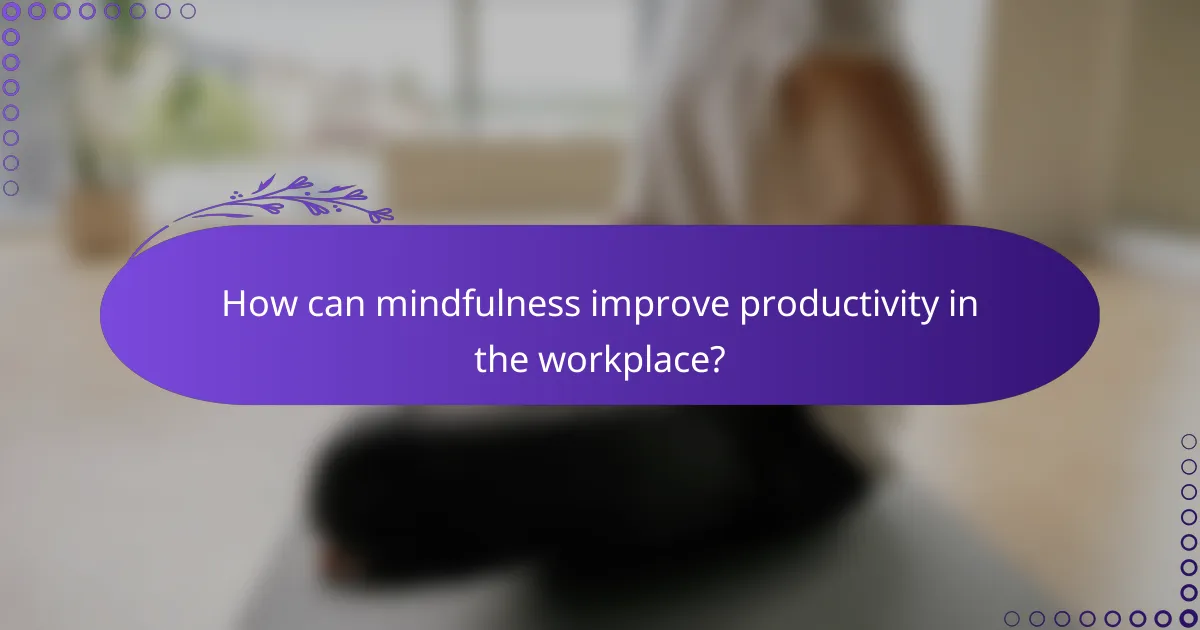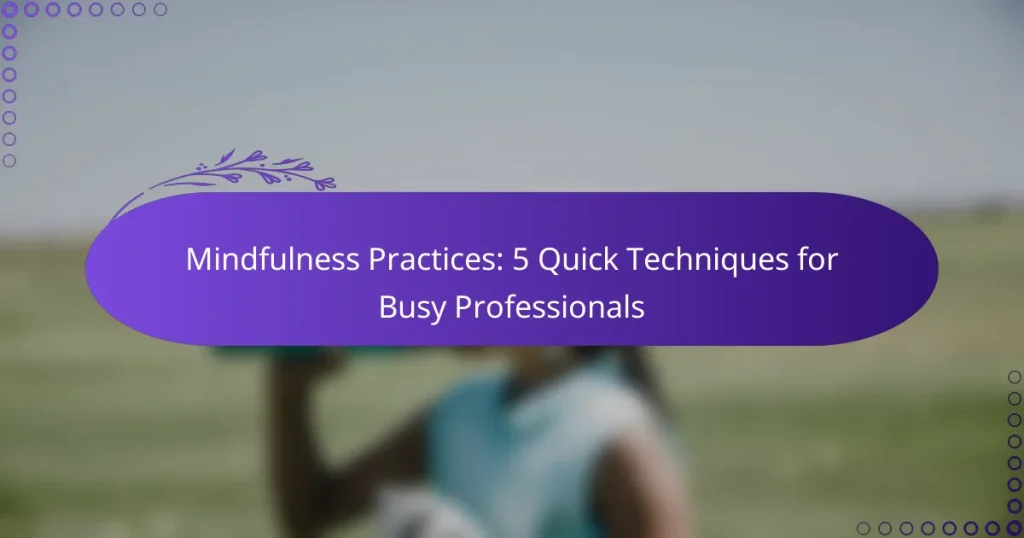For busy professionals, quick mindfulness techniques offer a practical way to enhance mental clarity and reduce stress amidst a hectic schedule. These simple practices can be seamlessly integrated into daily routines, requiring minimal time and effort while promoting greater focus and creativity. By embracing mindfulness, individuals can significantly improve their work performance and overall job satisfaction.

What are quick mindfulness techniques for busy professionals?
Quick mindfulness techniques for busy professionals are simple practices that can be integrated into a hectic schedule to promote mental clarity and reduce stress. These techniques require minimal time and can be done almost anywhere, making them ideal for those with demanding jobs.
Breathing exercises
Breathing exercises involve focusing on your breath to calm the mind and body. A common method is the 4-7-8 technique, where you inhale for four seconds, hold for seven seconds, and exhale for eight seconds. Practicing this for just a few minutes can significantly lower stress levels.
To incorporate breathing exercises into your day, try taking a few moments during breaks or before meetings. Aim for two to five minutes to reset your focus and energy.
Body scan meditation
Body scan meditation is a practice that involves mentally scanning your body for tension and releasing it. Start by lying down or sitting comfortably, then focus on each part of your body from head to toe, noticing any sensations or tightness.
This technique can take around 10-20 minutes and is best done in a quiet space. Regular practice can enhance body awareness and reduce physical stress, making it a valuable tool for busy professionals.
Mindful walking
Mindful walking combines physical activity with awareness of your surroundings. As you walk, pay attention to the sensation of your feet touching the ground, the rhythm of your breath, and the sights and sounds around you. This practice can be done during a break or while commuting.
Even a short five to ten-minute walk can help clear your mind and boost your mood. Try to walk in a natural setting, if possible, to enhance the experience.
Gratitude journaling
Gratitude journaling involves writing down things you are thankful for, which can shift your focus from stress to positivity. Spend a few minutes each day noting three to five things you appreciate, whether big or small.
This practice can be done in the morning or before bed and requires only a notebook or a digital app. Aim for consistency, as regular journaling can improve overall well-being and resilience.
Five senses technique
The five senses technique encourages you to engage each of your senses to ground yourself in the present moment. Take a moment to notice five things you can see, four things you can touch, three things you can hear, two things you can smell, and one thing you can taste.
This quick exercise can be completed in just a couple of minutes and is particularly useful during stressful moments. It helps redirect your focus and promotes mindfulness in everyday situations.

How can mindfulness improve productivity in the workplace?
Mindfulness can significantly enhance productivity by fostering greater focus, reducing stress, and boosting creativity among professionals. By incorporating mindfulness practices into daily routines, individuals can improve their overall work performance and job satisfaction.
Enhances focus
Mindfulness enhances focus by training the mind to concentrate on the present moment, minimizing distractions. Techniques such as mindful breathing or short meditation sessions can help professionals regain their attention when faced with interruptions.
To implement this, set aside a few minutes each day for focused breathing exercises. Aim for sessions of about 5-10 minutes, which can lead to improved concentration and efficiency in tasks.
Reduces stress
Practicing mindfulness can effectively reduce stress levels, which is crucial for maintaining productivity. By acknowledging and accepting thoughts and feelings without judgment, individuals can create a calmer mental state.
Consider incorporating a brief mindfulness break during the workday. Even a 3-5 minute pause to practice deep breathing or a quick body scan can help alleviate stress and enhance clarity for the tasks ahead.
Boosts creativity
Mindfulness can boost creativity by allowing the mind to explore new ideas without the constraints of stress or distraction. Engaging in mindfulness practices can open pathways for innovative thinking and problem-solving.
To foster creativity, try dedicating time to mindfulness exercises that encourage free thinking, such as journaling or guided imagery. Allocating 10-15 minutes for these activities can lead to fresh insights and enhanced creative output.

What are the prerequisites for practicing mindfulness?
Practicing mindfulness requires a few essential prerequisites that can enhance the effectiveness of the experience. Key factors include a willingness to engage in the practice and a quiet environment that minimizes distractions.
Willingness to engage
A genuine willingness to engage in mindfulness is crucial for its success. This means being open to the experience and committing time to practice regularly, even if it’s just a few minutes each day. Consider setting aside specific times for mindfulness to create a routine.
To cultivate this willingness, start with short sessions, gradually increasing the duration as you become more comfortable. Aim for consistency rather than perfection; even brief moments of mindfulness can yield benefits.
Quiet environment
A quiet environment significantly enhances the practice of mindfulness by reducing external distractions. Choose a space where you feel comfortable and can focus, whether it’s a dedicated room, a corner of your office, or a peaceful outdoor setting.
To create a conducive atmosphere, minimize noise and interruptions. Use soft lighting, comfortable seating, and consider using calming scents or background sounds, like gentle music or nature sounds, to enhance your experience.

How to integrate mindfulness into a busy schedule?
Integrating mindfulness into a busy schedule involves making intentional choices to prioritize mental well-being amidst daily tasks. By incorporating specific techniques, professionals can cultivate a sense of calm and focus without requiring extensive time commitments.
Set specific times
Setting specific times for mindfulness practices can help create a routine that fits into a busy lifestyle. Consider scheduling short sessions, such as 5-10 minutes in the morning or during lunch breaks, to practice mindfulness techniques like deep breathing or meditation.
Consistency is key; try to stick to the same times each day to build a habit. For example, you might choose to meditate right after waking up or before heading to bed, making it easier to remember and incorporate into your daily rhythm.
Use reminders
Using reminders can significantly enhance your ability to practice mindfulness regularly. Set alarms on your phone or use calendar notifications to prompt you to take mindfulness breaks throughout the day.
Additionally, consider placing visual cues in your workspace, such as sticky notes with motivational quotes or symbols that remind you to pause and breathe. These small prompts can help you stay mindful even during hectic workdays.

What tools can assist with mindfulness practices?
Several tools can enhance mindfulness practices for busy professionals, primarily through apps designed to facilitate meditation and relaxation. These tools provide structured guidance, making it easier to incorporate mindfulness into a hectic schedule.
Headspace app
The Headspace app offers a user-friendly interface and a variety of guided meditations tailored for different needs, such as stress relief or better sleep. Users can choose from sessions lasting just a few minutes to longer practices, making it adaptable to any schedule.
Headspace also includes features like “Sleepcasts” and “Focus Music,” which help create a calming environment. Professionals can benefit from its bite-sized content, allowing for quick sessions during breaks or commutes.
Calm app
The Calm app focuses on meditation, sleep, and relaxation techniques, providing a wide range of content including guided meditations, sleep stories, and soothing music. Its sessions can be as short as three minutes, making it easy to fit into a busy day.
Calm also offers themed programs, such as “Daily Calm,” which presents a new meditation each day. This feature encourages consistency and helps users build a regular mindfulness practice, essential for managing stress effectively.


